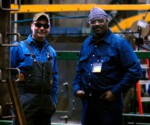 On a modern shop floor, you will find lots of data and documentation. These are quite useful to track and improve the situation in the operations. Many of them are quite nicely printed charts, diagrams, and tables of key performance indicators (KPIs). However, when I look closer at them, I often find that they were last updated six months ago, or even more than one year ago. That is useless in practical terms! You need up-to-date information if you want to manage a process. For this, entering data by hand is most useful. In this post I will discuss different advantages of tracking data by hand on the shop floor.
On a modern shop floor, you will find lots of data and documentation. These are quite useful to track and improve the situation in the operations. Many of them are quite nicely printed charts, diagrams, and tables of key performance indicators (KPIs). However, when I look closer at them, I often find that they were last updated six months ago, or even more than one year ago. That is useless in practical terms! You need up-to-date information if you want to manage a process. For this, entering data by hand is most useful. In this post I will discuss different advantages of tracking data by hand on the shop floor.
The Uselessness of Pretty But Obsolete Data

On many shop floors, lower and middle management opts for printed data. Modern computers make it easy to create beautiful and colorful graphics. Often, this is what the next level of management wants: pretty and good-looking charts that are easy to read – except that nobody really reads them!
The operators on the shop floor are too busy to bother with such data. Higher management is equally to busy. The latter case may actually be intentional, as befuddling higher management with data it is one of the top strategies to keep higher management in the dark about what is really going on. Hence, for shop floor management it is easier to look good without actually being good.
Yet, even with computer assistance, creating such drawings costs time. The actual act of creating the graphic may take only five minutes. However, humans are not good at working tasks back to back. We need some time to mentally prepare for the task, get our thoughts organized, maybe have a cup of coffee, etc., and in no time this five-minute task has used up thirty minutes of our time. Even then the chart still sits on the desk and is not yet on the shop floor.
Additionally, creating the chart by computer is usually not done by shop floor operators. Often they do not have access to computers. In effect, the charts are created by more educated (and hence more expensive) workers like foremen, shop floor supervisors, or managers. Overall, this will eat up a lot of time of people who are chronically short on time.
Draw It by Hand
The solution to all these and more problems: Draw the charts by hand! Or, to be more precise, enter the data in a pre-printed form by hand. This has quite a lot of advantages.
Shop Floor Involvement
 First and possibly most important, this can be done by the shop floor. Rather than having management add the data, have the shop floor operators add a point to a chart, or a number to a table, or a text marker for a red/yellow/green process.
First and possibly most important, this can be done by the shop floor. Rather than having management add the data, have the shop floor operators add a point to a chart, or a number to a table, or a text marker for a red/yellow/green process.
Since the shop floor operators have a huge influence on your performance measures, they need to be aware of these measures and their performance. With sheets printed by someone else, there is an additional effort to make your employees aware of the status of KPIs that are important to you. If they have to fill it out themselves, they automatically have to deal with this number.
Just to be sure: Of course you should pre-print an empty data sheet. It is not the task of the workers to draw x and y axes and write headlines, but rather to fill in the latest data points.
More Likely to be Up-to-Date, Hence More Likely to be Effective
 With the workers adding the data, your data will also be more up-to-date. It does not matter if it is normal office working hours or 3:00 AM on the night shift, the data can be updated whenever there are people working. Hence, whenever you visit the shop floor (hopefully often!), you can see the current state of your KPIs (in addition to all the things you can see just by being on the shop floor!)
With the workers adding the data, your data will also be more up-to-date. It does not matter if it is normal office working hours or 3:00 AM on the night shift, the data can be updated whenever there are people working. Hence, whenever you visit the shop floor (hopefully often!), you can see the current state of your KPIs (in addition to all the things you can see just by being on the shop floor!)
However, with all due respect, when you are seeing them, it is already too late to do something about these KPIs. The workers, however, can influence these KPIs. By adding these KPIs by hand, the workers are involved. They will be able to influence these KPIs, and most likely even before they are written down.
It Forces You to Make It Simple
 Yet another advantage of adding the KPIs by hand is simplicity! I have seen too many KPIs that required lengthy and complex calculations, resulting in a KPI that was no longer understood and also easily fudged (see for example my post Top Three Methods on how to Fudge Your OEE). In my experience, the more complicated a performance measure is, the less useful is it for actual measuring performance. Usually there are too many exceptions and loopholes to make the KPI look good.
Yet another advantage of adding the KPIs by hand is simplicity! I have seen too many KPIs that required lengthy and complex calculations, resulting in a KPI that was no longer understood and also easily fudged (see for example my post Top Three Methods on how to Fudge Your OEE). In my experience, the more complicated a performance measure is, the less useful is it for actual measuring performance. Usually there are too many exceptions and loopholes to make the KPI look good.
For example, I routinely don’t believe OEEs, delivery performance measures, cost calculations, and many more. Don’t get me wrong, it would be nice to have these numbers. I sometimes also calculate them myself if I need them for a project. But I do not use complicated KPIs without knowing in detail how they are calculated.
However, if the operators on the shop floor have to add the numbers, it forces you to keep it simple. Any complex math is usually lost on the shop floor. Instead, your KPIs have to be based on simple things that, for example, can be counted. On the shop floor I (usually) do believe quantities produced, time worked, workers present, and other such measures that are simple and easy.
No Lost Time for “Prettifying”
 Finally, it saves time for management or office workers. You do not have to print the same charts over and over again with one additional data point every week (bad) or every day (worse).
Finally, it saves time for management or office workers. You do not have to print the same charts over and over again with one additional data point every week (bad) or every day (worse).
As mentioned above, the updating and printing may be actually not too bad, but it will interrupt your other and possibly more important tasks. Overall, a simple five-minute print out can turn into thirty lost minutes. Hence, giving the task to the shop floor enables you to work more distraction free (assuming that you may have enough distractions coming in from other sources already 😉 ).
Occasions Where Printed Data May Be More Useful
In sum, try to use hand written KPIs on the shop floor whenever you can. However, there are a few instances where printing may be better. Most of them are pretty obvious:
Your superior wants pretty printed charts: Or, to phrase it differently, your superior does not promote or give raises to people that do not have pretty printed charts. If you have to choose between useful handwritten data and your career, by all means go for your career. You would be surprised how often such mundane details make or break a career, unfortunately.
Information that is needed frequently, and is needed for the process to work. For example when storing material on a shelf, the location should not be written by hand. Mistakes happen, and with a lot of locations, you will be searching for material frequently. In such instances scanning or RFID tags are a much more reliable method.
Information that changes only rarely, as, for example, work instructions. Of course they do change – in fact they should change, but not every day.
Legally required data: If the laws applicable to your plant require certain data or information posted on site, it may be better to print them.
Safety or quality instructions and warnings (but not KPIs about safety): Warning labels need to be visible. For obvious reasons, please do not use handwritten Emergency Exit signs or Toxicity warning labels. Similar is true, for example, if you have blocked stock, although the reason can be written by hand on a visible (usually red) tag. KPIs about safety and quality, on the other hand, can be written by hand again. This includes, for example, accidents per month (hopefully none) or defects per day (also hopefully none, but if I could choose I’d rather go for no accidents).
In any case, try to use handwritten data filled in by the shop floor wherever you can. I hope this post was useful for you. Now go out and improve your Industry!

Excellent post Christian.
During a visit (2014), at the Toyota Material Handling lift truck factory in Columbus, Indiana, I was surprised to see that most of charts and kpi were all drawed or filled by hand.
Well, this is the right way, because like you said, it involves the floor workers and they are the one who can make a difference.
Shop-floor data may be updated every day, twice a day or even hourly. Up-to-the-moment real time data is the prerogative of the ‘Top Floor’, who are the decision makers, and there are sophisticated systems to do that, viz., SFAC and MES. If these are integrated with SAP xMII (SAP Manufacturing Integration and Intelligence), the top floor will have the most reliable operations data moment by moment. At best, the shop-floor data will remind, inform or motivate the workmen who are operating the machines. These printed charts, diagrams, and tables of key performance indicators (KPIs) may be attractive to look at but seldom motivate the workmen. A white board, at a prominent location, having neatly hand-written with vital information about their machines will induce the workmen and serve better purpose, which may be updated with current data at fixed intervals. I have seen such boards with hourly data, say for example, ‘The Blow-pit Position in wood pulp and cellulose manufacturing.